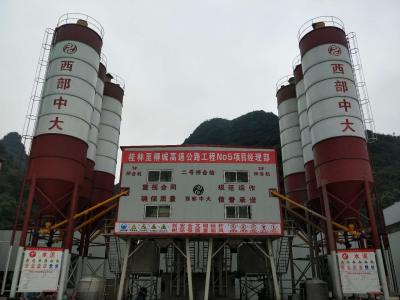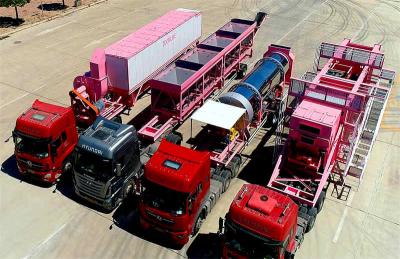Some measures on winter concrete production in mixing plant
Some measures on winter concrete production in mixing plant
Concrete anti-freezing measures are not only a matter of using antifreeze, but a systematic, comprehensive and integrated problem. For example: insulation and preheating of raw materials, the use of antifreeze, adjustment and control of the mix ratio, transportation, scheduling management measures, concrete insulation and maintenance and other anti-freezing measures should be considered in an integrated manner to control key factors. The use of high-quality raw materials is an important part of the concrete frost protection, should use a variety of raw materials with low water content, to strictly control the degree of weathering of sand and gravel, strict detection of the content of the active ingredients in the antifreeze agent, to prevent the quality of raw materials caused by the concrete frost protection effect discount.
(A) the winter concrete raw materials selection and ratio
(1) cement. Cement should choose silicate cement or ordinary silicate cement. Cement hydration is greatly affected by temperature, and the hydration of the admixture to be affected by both the amount of cement hydration products and temperature, the temperature effect is greater. Early strength of concrete as soon as possible to grow to critical strength, should be appropriate to increase the amount of cement, reduce the amount of admixtures. Increased cement dosage can improve the early strength of concrete, at the same time, the increase in heat of hydration will also slow down the rate of temperature reduction of concrete itself. In addition, the configuration of concrete, but also in conjunction with the construction site and site concrete warming measures.
(2) Aggregate. Sand and gravel aggregates in addition to meeting the quality and technical specifications required for concrete, attention should also be paid to not using aggregates containing ice. Should minimize the heat loss of stored sand and gravel materials, if the outer layer of the sand pile frozen shell has formed, the use of materials, should remove the frozen shell, try to avoid frozen sand blocks into the mixer sand and gravel containing ice and frozen blocks. Because in the production of mixing process these frozen blocks are not easy to be mixed away, affecting the uniformity of the concrete mix. In addition, the frozen blocks of sand and ice in the concrete mixer out of the machine, in the cement under the action of the heat of hydration melted into water, on the one hand, to absorb part of the heat, resulting in lower temperatures when the concrete is poured into the mold; on the other hand, the ice and frozen blocks of sand and stone melted into liquid water caused by the increase in liquid free water in the concrete mix, often resulting in the slump out of the machine to meet the design requirements, transported to the site slump is too large, and even segregation Delamination. In addition, the fusion of ice and frozen blocks in the sand and gravel aggregate into water will also cause the actual production of concrete water consumption becomes larger, the water-cement ratio increases. When storing materials in the closed material shed, ensure the airtightness of the material shed to prevent the inflow of cold air.
(3) Admixture. In order to make the concrete has a high early strength, winter concrete production should be controlled according to the temperature of the variety and amount of admixtures. The heat of hydration produced by cement hydration is the main source of internal heat of concrete, research shows that the amount of cement increased by 10kg/m 3, the internal hydration temperature of concrete increased by 1 ℃. The rise in the early temperature of concrete, corresponding to accelerate the time to reach critical strength. In the winter construction encountered a sudden drop in temperature windy very cold weather, the cement should be used early hydration heat of early strength type cement, concrete production should be appropriate to increase the amount of cement 10 ~ 20kg / m 3, and appropriate to reduce the amount of fly ash and other mineral admixtures. Fly ash to replace the amount of cement less than 30%, the impact on the concrete frost resistance is not significant, more than 30%, will make the concrete frost resistance deterioration.
(4) admixtures. In the winter concrete production, according to the weather conditions compound using antifreeze or early strength agent to improve the early strength of concrete, accelerate the hydration of cement, reduce the freezing point of concrete free water. Such as the addition of alkali metal or alkali metal nitrate or nitrite are to promote the hydration of cement, sodium nitrite can also form a protective film on the steel to play a rust-inhibiting effect, therefore, the use of chlorine salt antifreeze agent often compound sodium nitrite. Triethanolamine can promote the hydration of C 3A to accelerate the formation of calcium alumina, triethanolamine and chloride salt compound as early strength agent, early strength effect is more, such as triethanolamine 0.02 ~ 0.05% + sodium chloride 0.3 ~ 0.5% + sodium nitrite 1 ~ 2%. If the compound air-entraining agent in the admixture, should control the air content of concrete in 3 ~ 5%.
(5) matching ratio. The size of the water-cement ratio in concrete directly affects the content of concrete freezable water, the larger the water-cement ratio, the more free water in concrete, the faster the freezing rate, the lower the strength of concrete, the poorer the frost resistance. Reduce the concrete water-cement ratio, you can reduce the content of free water in concrete and improve the strength of concrete. Winter concrete production, should improve the amount of water reducing agent, minimize the water-cement ratio, reduce the slump. Water use control has been proved through a large number of tests that when the total water use is reduced to below 170kg, the frost resistance of concrete is significantly improved. This shows that reducing the water-cement ratio in concrete, the concentration of liquid phase ions in concrete increases, the freezing point decreases, and the chance of concrete being frozen decreases, therefore, the water-cement ratio should be reduced as much as possible when formulating concrete. Countries on the winter construction of the ratio of water-cement ratio are made: the United States ACI 318 requirements for wet conditions freezing and thawing concrete, the maximum water-cement ratio should be 0.45, other components for 0.5; Japan Construction Institute for frozen concrete maximum water-cement ratio of 0.55; Germany's relevant standards also provide for the maximum water-cement ratio of not less than 0.5, greater than 0.5 must induce gas. China's water-cement ratio should not be greater than 0.55, cementitious material is not less than 280kg/m3, from the actual concrete production, strength grade greater than C25 concrete water-cement ratio and the amount of cementitious material can meet the requirements of the concrete winter construction specifications.
(B) Frostproof and thermal insulation measures for mixing plant equipment
(1) Thermal insulation measures for all parts of the mixing plant. The necessary insulation measures should be taken in the mixing plant to ensure that the ambient temperature is greater than 5℃ and the equipment is running normally. Belt and electronic valve should be kept at positive temperature to ensure normal opening.
(2) Liquid admixture storage tank should pay attention to thermal insulation to prevent freezing of pipes.
(3) compressed air containing water is suitable for icing, can take in the air compressor storage tank into alcohol to reduce the freezing point.
(4) pay attention to the water line, pump insulation.
(C) concrete production control
In the winter period, the air and water lines of the mixing plant (building) should be insulated as far as possible, and the water and air lines should be emptied at the end of production to prevent frost damage. The lower part of the gravel storage hopper of the mixing plant is sealed with thermal insulation cotton curtain, which can also ensure that the air and solenoid valves are working at positive temperature. At the end of concrete production every day, the remaining material in the gravel storage hopper is discharged from the storage bin through the conveyor belt and mixer and returned to the gravel quarry to prevent the gravel freezing material from blocking the lower feeding port, and the main engine room of the mixing plant should be kept at room temperature of not less than 5℃.
Mixing concrete using the method of heating water, when the heating water does not reach the requirements of the thermal engineering calculations, the aggregate heating method is used, the maximum temperature of water and aggregate heating should be in accordance with the following table, the specific temperature value is determined by the thermal engineering calculations, and the concrete transport truck must be insulated.
Winter concrete production, the belt should be opened in advance before production to observe the operation. The host transfer signal is normal, winter production should extend the mixing time 10 ~ 15s, to ensure the uniformity of the concrete. The personnel on duty should measure the temperature of concrete out of the machine and out of the tank, 2 times per shift.
(D) Concrete transportation
In the process of concrete pouring, the dispatching office should strengthen the contact with the construction site, grasp the construction pouring speed, control the number of trucks sent, should not send too many trucks to the same site to prevent the concrete from waiting too long at the site, and the temperature of concrete into the mold is too low. In general, the temperature of concrete out of the machine shall not be less than 15℃, and the temperature of concrete transported to the construction site shall not be less than 10℃, and control the concrete to be poured within 60min, which can ensure the temperature into the mold is more than 5℃. When the temperature is lower than -5℃, the exterior of the concrete transport tanker should be equipped with an insulation cover to prevent the heat loss of concrete



